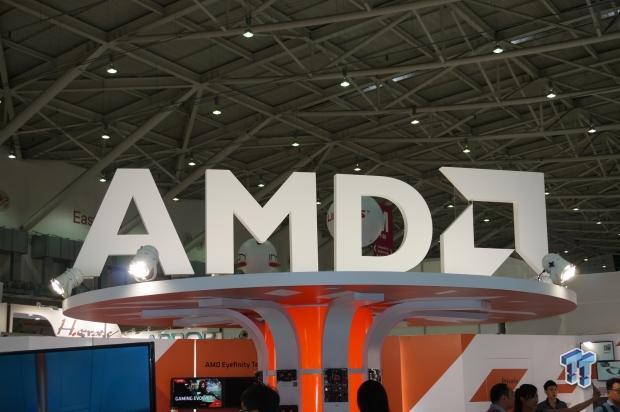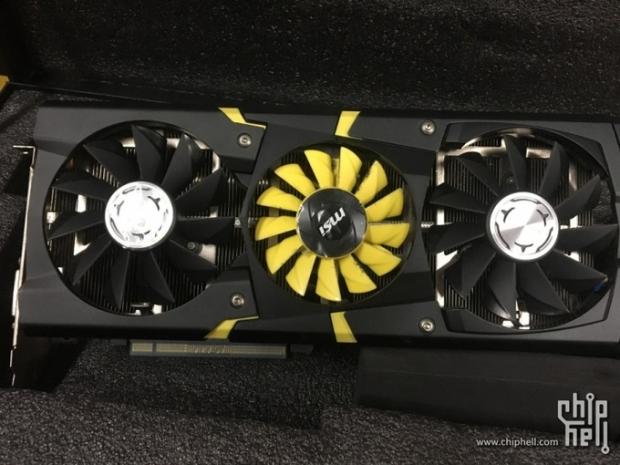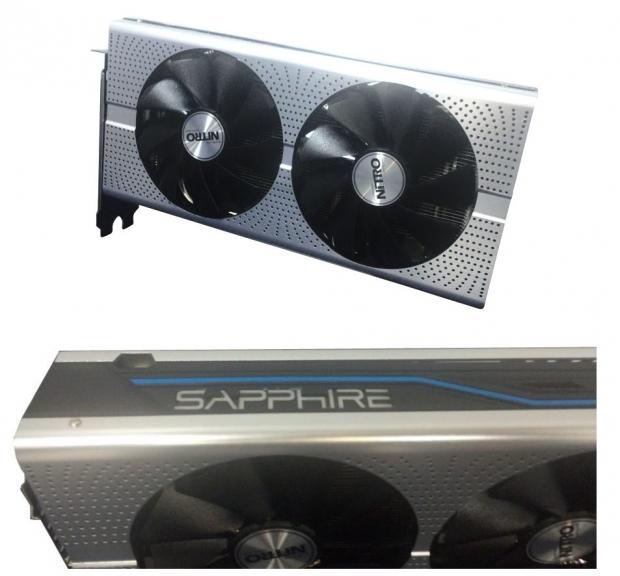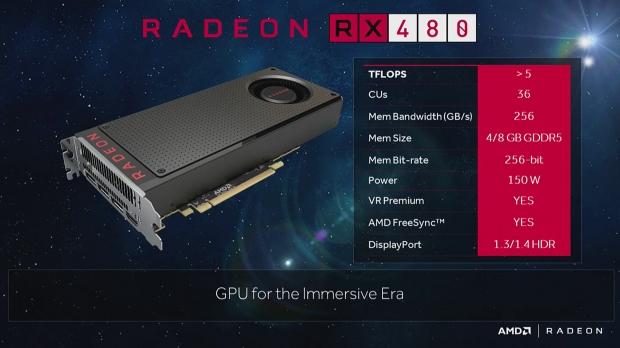Video Cards & GPUs News - Page 317
Leaked benchmarks see the Radeon RX 480 beating the GeForce GTX 980
AMD is preparing it's new 'The Uprising' marketing campaign for its Polaris launch, led by the Radeon RX 480 priced at $199, but how does it perform in benchmarks other than Ashes of the Singularity? Well, according to one leaked benchmark, the RX 480 beats the GTX 980 from NVIDIA in 3DMark Fire Strike.
We can see the NVIDIA GeForce GTX 980 with its 3038 score, versus the RX 480 and its higher 3194. It might not be much, but considering the RX 480 4GB (which is the card benchmarked here) is going to be priced at $199, and while NVIDIA's GeForce GTX 980 still sells on Amazon right now (at least at the time of writing) for $450+, AMD is onto a massive winner here. I don't want to throw my personal or professional weight behind it until I do my own independent testing, but I'm beginning to get excited about what AMD has on its hands - and that $199 price point, wow.
In the last 24 hours, we've seen the purported MSI Radeon RX 480 Lightning and SAPPHIRE Radeon RX 480 Nitro cards, both rocking 4GB of framebuffer. Personally, I love the look of the Lightning cooler over the cheese grater look SAPPHIRE has opted for - but these are leaks, we could expect some changes and different models before release.
Continue reading: Leaked benchmarks see the Radeon RX 480 beating the GeForce GTX 980 (full post)
AMD's new 'The Uprising' marketing campaign has been revealed
AMD is on different footing since spinning off its GPU division into Radeon Technologies Group, with our own Jason Evangelho breaking a story through Forbes about RTG's new goals - kicking off its impressive 'The Uprising' marketing campaign.
Jason spoke with RTG boss Raja Koduri and Chris Hook (who is still looking for the Hydrofoil) about their new focus on the mid-range market, and what it means for gamers. Jason reported:
The first note is something worth actually noting - as this is something I totally agree with Chris Hook on. People want the $700 video card, but they don't have the money to pay for it - well, that's where the Radeon RX 480 4GB model priced at $199 steps in. The second note is "VR that just works" - this is how VR needs to be, easy. Ridiculously easy. Not having to upgrade PSUs, motherboards and operating systems goes a long way into keeping consumers happy.
Continue reading: AMD's new 'The Uprising' marketing campaign has been revealed (full post)
MSI's purported Radeon RX 480 Lightning teased, has triple-fan cooler
Update: MSI has reached out to us, saying that this is "fake without any doubt". The full statement from MSI: "This stuff is way too retro for any new product...I can guarantee you this is fake without any doubt, There is no need to be too serious about it :)".
Just 24 hours after the leaks on the purported SAPPHIRE Radeon RX 480 Nitro 8GB appear, we have the world's first look at the MSI Radeon RX 480 Lightning, powered by AMD's next-gen Polaris architecture, and rocking a triple-fan cooler.
The leaks are coming from Chiphell, with two photos of the card and some 3DMark benchmarks. The first shot of the card shows off that beautiful Lightning cooler, with a triple-fan system keeping the Polaris 10 GPU nice and cool, with a gorgeous black/white design. I'm definitely loving the look of MSI's offering versus the RX 480 Nitro from SAPPHIRE.
Continue reading: MSI's purported Radeon RX 480 Lightning teased, has triple-fan cooler (full post)
SAPPHIRE's Radeon RX 480 Nitro 8GB spotted, the first custom RX 480
The first pictures of a custom AMD Radeon RX 480 have arrived, with the SAPPHIRE Radeon RX 480 Nitro 8GB making an appearance, rocking a new silver cooled shroud with a dual-slot, dual-fan design.
SAPPHIRE's upcoming Radeon RX 480 Nitro 8GB features an LED-illuminated SAPPHIRE logo, with VideoCardz's source stating that the colors will change depending on the fan speed, GPU temperatures, or a custom profile that the user can set.
The Radeon RX 480 reference design from SAPPHIRE has been revealed, with it being quite a short card, with the cooler extending past the end of the PCB, ensuring that the RX 480 will run nice and cool under option, and only requiring a single 6-pin PCIe power connector.
Continue reading: SAPPHIRE's Radeon RX 480 Nitro 8GB spotted, the first custom RX 480 (full post)
Leaked benchmarks on AMD Radeon RX 480 hits minimum VR spec for $199
The release of AMD's next-gen Radeon RX 480 isn't too far away, but we have no real performance data on the Polaris-based video card, until now. According to benchmarks on the 3DMark database, the RX 480 has achieved a 3DMark 11 Performance Score of 14,461 - not bad for a card worth $199.
At this performance level, AMD will have no issues with the RX 480 meeting the minimum VR spec, but it'll also handle 1080p and 1440p gaming like a champion. Again, for $199 to $229, depending on whether you want the 4GB or 8GB model. With VR headset sales set to expand over the coming years, AMD is positioning itself incredibly well for consumers. Sure, the GeForce GTX 1070 and GTX 1080 kick some serious ass, but not everyone has $400-$699 to spend on a video card - but $199? That's a huge market.
We have Radeon RX 480 samples coming soon, but we can't tell you when our review will be up - but stay tuned to TweakTown for more information on Polaris very soon.
Continue reading: Leaked benchmarks on AMD Radeon RX 480 hits minimum VR spec for $199 (full post)
Colorful announces its new iGame GeForce GTX 1070 X-TOP-8G video card
Colorful impressed us so much at Computex 2016 with their range of GeForce GTX 1070 and GTX 1080 video cards, but now the company has made their GTX 1070 video cards official, with a few different variants.
The company has launched three GTX 1070 cards, with the iGameGTX1070 X-TOP-8G, followed by the iGameGTX1070 U-TOP-8G (guys, you need to use a space bar...) and of course, the Colorful GTX 1070-8G Founders Edition. All three cards don't vary from the 16nm FinFET-powered Pascal GPU, with its 1920 CUDA cores and 8GB of GDDR5 clocked at 8GHz on a 256-bit memory bus.
Colorful hasn't provided clock speeds just yet, but we should expect something special from the iGame-branded cards. We do know that both of the cards are based on the i-MSD from Colorful, which is the iGame-Modular Structure Design. The iGame-based cards have a 'new cooling base' and 8+2-phase power, with a newly designed cooling fan which is sure to keep the GP104-powered card nice and cool, even when hitting those huge overclocks.
Continue reading: Colorful announces its new iGame GeForce GTX 1070 X-TOP-8G video card (full post)
NVIDIA GeForce GTX 1080 roundup at Computex 2016, nerd overload
Computex 2016 - Ugh, there were so many GeForce GTX 1080 cards at Computex 2016, that I literally had a nerd overload. NVIDIA's GeForce GTX 1080 Founder's Edition is a beautiful card on its own, but the custom design cards are... well... just so freakin' beautiful. We have a small roundup video below that you can check out.
We caught a glimpse of what MSI were showing off, some of the cards from GIGABYTE, as well as the monster GTX 1080 AMP! Extreme Edition from ZOTAC. One of the new members on the block is Colorful, which most of you have probably never heard of. Colorful is a gigantic Chinese video card maker that should be sampling us in the very near future as the first media in the world outside of China to receive a Colorful video card. I even introduced Luke from Linus Tech Tips to Colorful, as I love his work on video (and he's a super-cool guy as well), so expect some major exposure from Colorful in the future.
MSI's cards impressed me, as I have their GTX 1080 GAMING X 8G in the house right now and have been benchmarking it for days. I also have the G1 GAMING edition of GIGABYTE's GeForce GTX 1080 which will be benchmarked next week. So expect a flood of GTX 1080 reviews before AMD flings their Polaris-based offerings led by the Radeon RX 480 into the wild later this month.
Continue reading: NVIDIA GeForce GTX 1080 roundup at Computex 2016, nerd overload (full post)
NVIDIA 368.39 drivers prepare you for Mirror's Edge: Catalyst
AMD released new drivers for the just launched Mirror's Edge: Catalyst today, and NVIDIA is hot on their heels.
Apart from preparing you for DICE's parkour game, the GeForce 368.39 set contains optimizations for the GTX 1070 releasing on Friday and Edge of Nowhere performance improvements for you Oculus Rift owners.
Mirror's Edge has seen performance complaints from some early players across the web, so hopefully between the two sets of drivers, the game is now in good shape.
Continue reading: NVIDIA 368.39 drivers prepare you for Mirror's Edge: Catalyst (full post)
AMD's new drivers include optimizations for Mirrors Edge Catalyst
AMD has just unleashed a new set of Radeon Software Crimson Edition drivers, with the new 16.6.1 set of drivers including some optimizations for both Mirror's Edge Catalyst and Paragon. Not only that, but we have a new CrossFire driver for Dark Souls 3, too. You can download the new RSCE 16.6.1 drivers here.
As for the release notes, here's what to expect from Radeon Software Crimson Edition 16.6.1:
Support for:
Continue reading: AMD's new drivers include optimizations for Mirrors Edge Catalyst (full post)
GALAX cranks its GeForce GTX 1080 to 2.5GHz with liquid nitrogen
The NVIDIA GeForce GTX 1080 is already a super-fast video card, but what happens when you crank the GP104 GPU to 2.5GHz on liquid nitrogen? Yeah, well GALAX has been the first to do so, using their overclocking skills on their own GALAX GeForce GTX 1080 HOF OC video card, as reported by Nordic Hardware.
GALAX drove the GPU right up to a huge 2.5GHz using LN2 cooling, matched up with the new Intel Core i7-6950X processor, but even at 2.5GHz, it couldn't beat the GTX 980 Ti and Titan X at 2.2GHz. But remember, we're in the early days of the GTX 1080, so we should expect much more in the future.
The GALAX GeForce GTX 1080 HOF OC rocks 2 x 8-pin PCIe power connectors, but now I have to wonder... when will we see 3GHz on a GTX 1080?
Continue reading: GALAX cranks its GeForce GTX 1080 to 2.5GHz with liquid nitrogen (full post)






